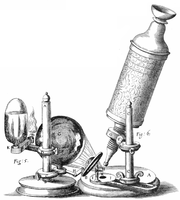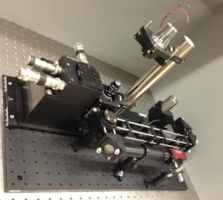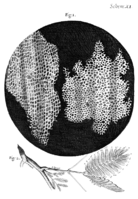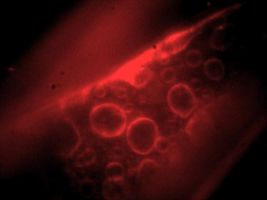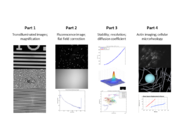Difference between revisions of "Lab Manual: Optical Microscopy"
(→Introduction) |
|||
| Line 31: | Line 31: | ||
==Introduction== | ==Introduction== | ||
| − | Robert Hooke was not the first person to look at | + | Robert Hooke was not the first person to look at biological samples with a microscope. But many factors make his early studies of magnified, biological samples stand out. He noticed that a sample of cork's texture reminded of the small rooms called ''cells'' where monks sleep in a monastery. But he took an important step beyond that qualitative observation. Hooke went on to make perhaps the first quantitative, biological measurement with an optical microscope. He measured the size of cells. |
And Hooke could draw. Really ... really ... well. | And Hooke could draw. Really ... really ... well. | ||
Revision as of 14:49, 23 January 2014
| 1665 | 2009 |
|---|---|
|
Robert Hooke's microscope |
20.309 student's microscope |
|
Hooke micrograph of cork cells |
CCD image of fluorescent labeled intracellular membranes[1] |
I took a good clear piece of Cork, and with a Pen-knife sharpen'd as keen as a Razor, I cut a piece of it off, and thereby left the surface of it exceeding smooth, then examining it very diligently with a Microscope, me thought I could perceive it to appear a little porous; but I could not so plainly distinguish them, as to be sure that they were pores, much less what Figure they were of: But judging from the lightness and yielding quality of the Cork, that certainly the texture could not be so curious, but that possibly, if I could use some further diligence, I might find it to be discernable with a Microscope, I with the same sharp Penknife, cut off from the former smooth surface an exceeding thin piece of it, and placing it on a black object Plate, because it was it self a white body, and casting the light on it with a deep plano-convex Glass, I could exceeding plainly perceive it to be all perforated and porous, much like a Honey-comb, but that the pores of it were not regular; yet it was not unlike a Honey-comb in these particulars.
I told several lines of these pores, and found that there were usually about threescore of these small Cells placed end-ways in the eighteenth part of an Inch in length, whence I concluded there must be neer eleven hundred of them, or somewhat more then a thousand in the length of an Inch, and therefore in a square Inch above a Million, or 1166400. and in a Cubick Inch, above twelve hundred Millions, or 1259712000. a thing almost incredible, did not our Microscope assure us of it by ocular demonstration.
Introduction
Robert Hooke was not the first person to look at biological samples with a microscope. But many factors make his early studies of magnified, biological samples stand out. He noticed that a sample of cork's texture reminded of the small rooms called cells where monks sleep in a monastery. But he took an important step beyond that qualitative observation. Hooke went on to make perhaps the first quantitative, biological measurement with an optical microscope. He measured the size of cells.
And Hooke could draw. Really ... really ... well.
Hooke meticulously documented his observations and published them in a book called [Micrographia]. blah blah blah ...
Since Robert Hooke noticed that the pores in a very thin sample of cork reminded him of the , optical microscopy has been a tool of central importance in life science. Improvements in optical components, microscope designs, illuminators, imaging devices, and sample preparation methodologies fostered increasingly sophisticated discoveries in the three and a half centuries since Micrographia. Barbara McClintock observed genetic transposition through an optical microscope by in 1944, for example. She was a talented microscopist who developed a technique that let her visualize and differentiate individual chromosomes in Zea Mays (corn) plant cells. McClintock was awarded the Nobel Prize in Physiology or Medicine in 1983 for this discovery. It took several decades before molecular techniques sufficiently sophisticated to confirm her discovery were developed.[3]
The principal challenges that Hooke faced
But Hooke
In this lab, you will design and build an optical microscope. The microscope will be made out of lenses, optic mounts, You will make images using transmitted brightfield and epifluorescence contrast, characterize the performance of your instrument, and make quantitative measurements of the movements of objects in the field of view.
How to do this lab
This lab is divided into 4 one-week sections. Each section requires some lab work and some data analysis. A group report is required for each section. One group member should submit a PDF format document to Stellar before the deadline. The file name should include the last names of all group members.
An example microscope made by the instructors will be available in the lab for you to examine. Feel free to make improvements on this design. Mechanical stability will be crucial for the particle tracking experiments in parts 3 and 4 of the lab. The required stability specification will be achieved through good design and careful construction — not by indiscriminate over-tightening of screws.
The final report should consist of all 4 sections in a single file. In the final document, you may revise any part of the first three sections without penalty. Only the final report will be graded. You may not skip any of the weekly reports.
Follow the format suggested in the Microscopy report outline.
After the lab work is complete, each student will make a 10 minute, individual presentation to one of the instructors. The presentation will be followed by 5 minutes of open questions and (if you want a good grade) answers.
Microscope design
Brightfield transmitted microscopy is the simplest and most common optical microscopy method. In this technique, photons from an illuminator pass through the sample, where they may be absorbed, diffracted, or refracted. (The sample is usually mounted on a glass slide.) An objective lens on the opposite side of the sample collects the light.
Illumination for epi-fluorescence microscopy reaches the sample through the objective lens — from the same side of the sample that is observed. Epi-fluorescence microscopy is normally used on samples that have been labeled with a fluorescent molecule called a fluorophore. The (narrowband) illumination wavelength must match the absorption characteristic of the fluorophore. After becoming excited by a photon from the illuminator, fluorophores emit photons with a longer wavelength. A dichroic mirror in the microscope reflects the illumination wavelength but allows the emitted photons to pass through.
The imaging path of the microscope includes an objective lens (L1) and a tube lens (L2). The sample is placed at the front focus of L1, producing collimated light that reflects of mirror M1. L2 forms an image of the sample on a CCD camera. In brightfield mode, collimated light from an LED passes through the sample. A green laser illuminates the sample in epi-fluorescence mode. Laser light passes through a Gallilean beam expander (L3 and L4). L5 focuses the laser beam at the back focus of L1. This arrangement provides collimated sample illumination. Dichroic mirror DM reflects the green light toward the sample and allows emitted red light to pass through.
Part 2: fluorescence microscopy
- Read background references
- Refer to Optical Microscopy Part 2: Fluorescence Microscopy
- Add a laser illumination beam path
- Image fluorescent samples
- Characterize the fluorescent imaging performance of the microscope
- Process images
- Turn in Part 2 report
Part 3: particle tracking
- Read background references
- R. Newburgh, Einstein, Perrin, and the reality of atoms: 1905 revisited, Am. J. Phys. (2006). A modern replication of Perrin's experiment. Has a good, concise appendix with both the Einstein and Langevin derivations.
- A. Einstein, On the Motion of Small Particles Suspended in Liquids at Rest Required by the Molecular-Kinetic Theory of Heat, Annalen der Physik (1905).
- M. Haw, Colloidal suspensions, Brownian motion, molecular reality: a short history, J. Phys. Condens. Matter (2002).
- E. Frey and K. Kroy, Brownian motion: a paradigm of soft matter and biological physics, Ann. Phys. (2005).
- Random Force & Brownian Motion — 60 Symbols
- Refer to Optical Microscopy Part 3: Particle Tracking
- Track fixed beads and measure microscope stability
- Track suspended microspheres
- Estimate diffusion coefficients in a Newtonian fluid; calculate viscosities
- Turn in Part 3 report
Part 4: cellular microrheology
- Read background references
- Refer to: Optical Microscopy Part 4: Microrheology Measurements in Fibroblast Cells
- Image actin in 3T3 cells before and after exposure to cytochalasin D, an inhibitor of actin polymerization
- Measure the frequency-dependent storage and loss modulus of 3T3 cells
- Begin Final report (see due date on Stellar)
Optical microscopy lab
Code examples and simulations
- Converting Gaussian fit to Rayleigh resolution
- MATLAB: Estimating resolution from a PSF slide image
- Matlab: Scalebars
- Calculating MSD and Diffusion Coefficients
Background reading
- Geometrical optics and ray tracing
- Physical optics and resolution
- Optical aberrations
- Aperture and field stops
- Optical detectors, noise, and the limit of detection
- Manta G032 camera measurements
- Understanding log plots
References
- ↑ Onion endothelial cell incubated with FM 4-64 dye (Invitrogen). See class stellar site for protocol. Oh & Yamaguchi, unpublished lab report
- ↑ Hooke, R. Micrographia: or Some Physiological Descriptions of Minute Bodies made by Magnifying Glasses with Observations and Inquiries Thereupon London:Jo. Martyn, and Ja. Allestry, Printers to the Royal Society; 1665
- ↑ See, for example: McClintock, B. The origin and behavior of mutable loci in maize. PNAS. 1950; 36:344-355. [1], [2], and Endersby, Jim. A Guinea Pig's History of Biology. Cambridge, Massachusetts: Harvard University Press; 2007.

